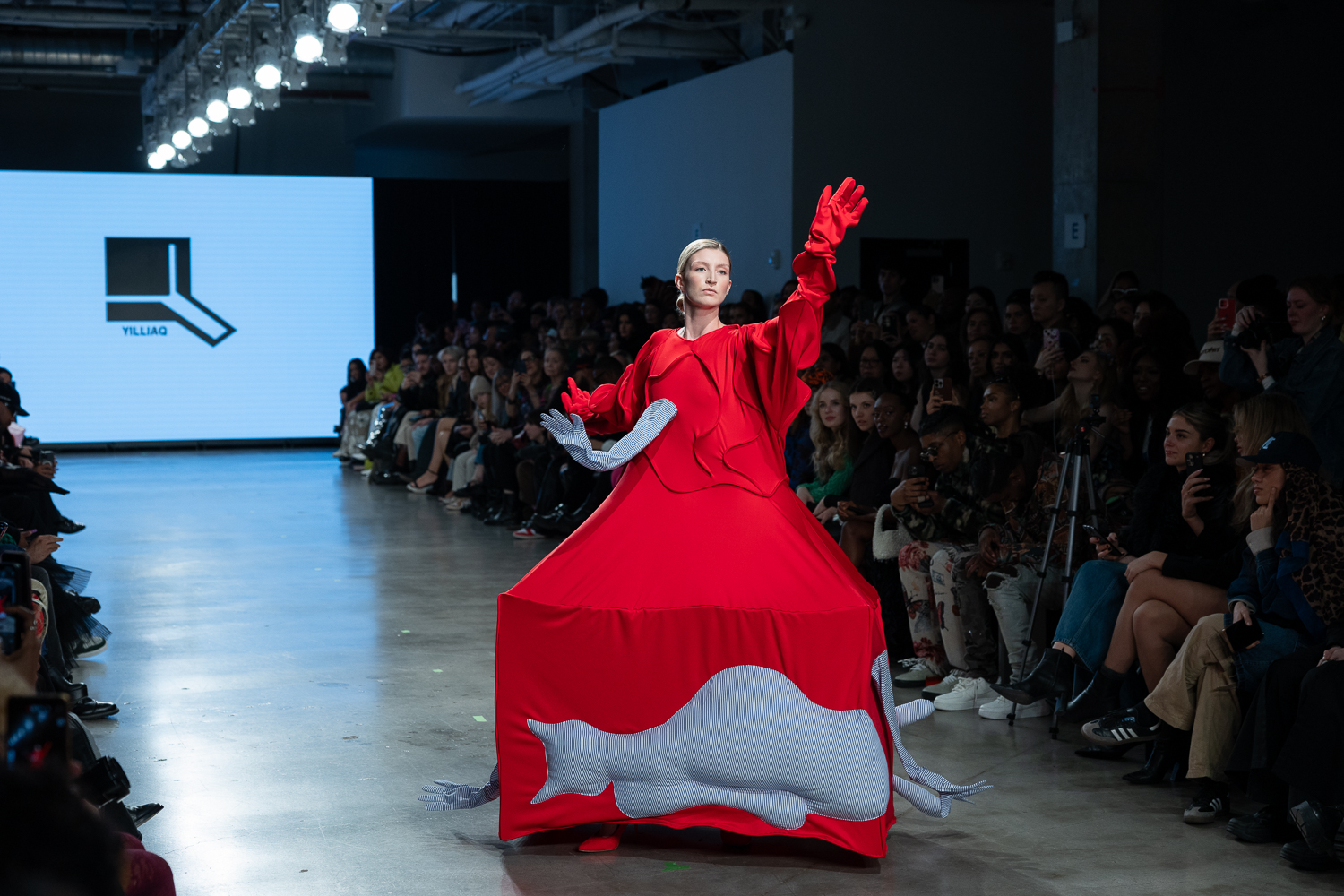In an unassuming Chelsea warehouse on Friday evening lived various worlds of fashion — from traditional Mongolian dresses to geometric-shaped garments — for Global Fashion Collective’s second day of Fall/Winter 2024 shows. Streetwear showed influences from Japan to Canada, and colors mixed with patterns in unconventional and creative ways. Each designer’s work contrasted heavily with the next, but the differences between each show somehow worked together to create a visually interesting experience.
———————————
SHOW I
By Emily Genova, Deputy Managing Editor
———————————
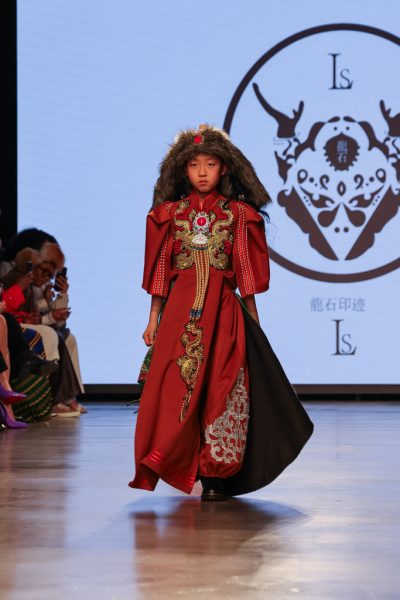
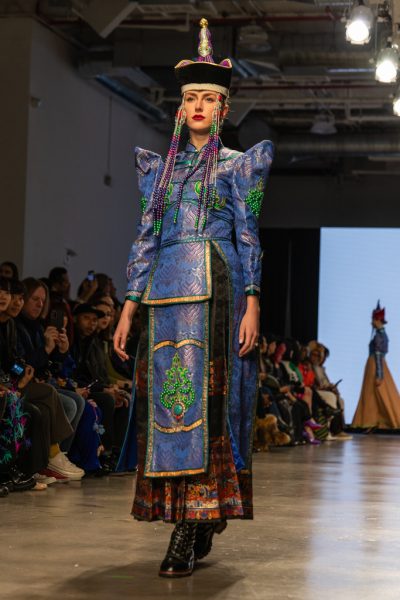
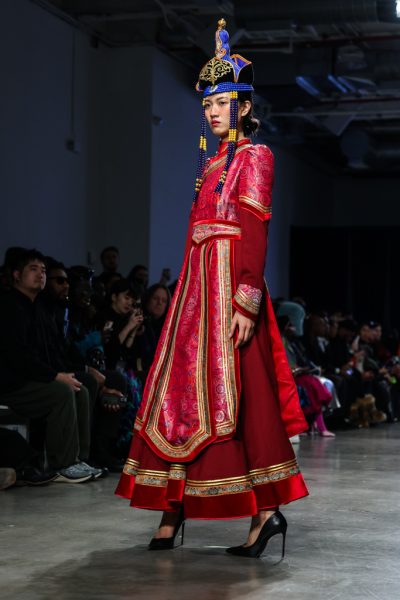
The Longshi show included long, layered gowns complete with a mesh of patterns and colors. Some models wore headpieces that tied the complexity of their looks together. The colors were bright and decadent; rich blues, reds and golds made the collection feel luxurious.
Highlighting the extravagance of the culture was an important part of the designs. In an interview with WSN, Huan Jiang, the operations director for Longshi, explained that the show itself meant to convey a traditional Chinese story focused on the idea of inheritance — hence the use of children as some of the models. The old-fashioned garments were intended to represent the country’s successes. “Children are the future of the world, of the country,” Jiang said.
The looks were notably a little repetitive, possibly since they all followed the basis of traditional Mongolian wear. That being said, the uniformity of the designs was not a downfall — it helped create a cohesive collection. Each model wore carefully crafted pieces with contrasting patterns and fabrics. And while the harsh lights of the runway highlighted a few loose threads, every individual outfit was stunningly beautiful and complex.
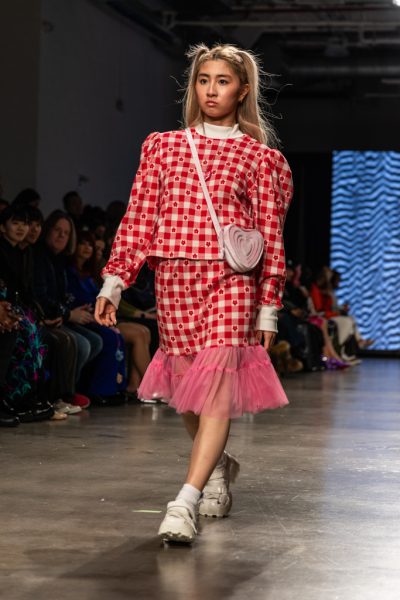
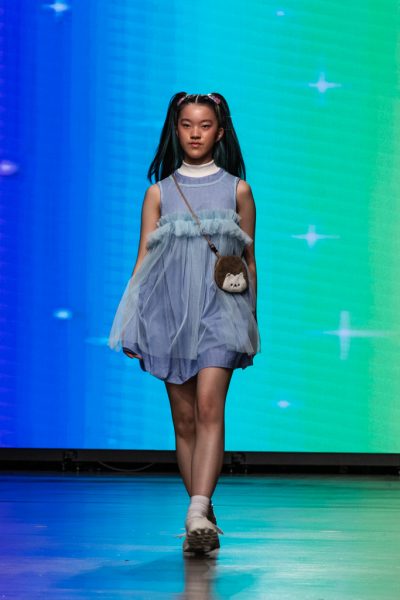
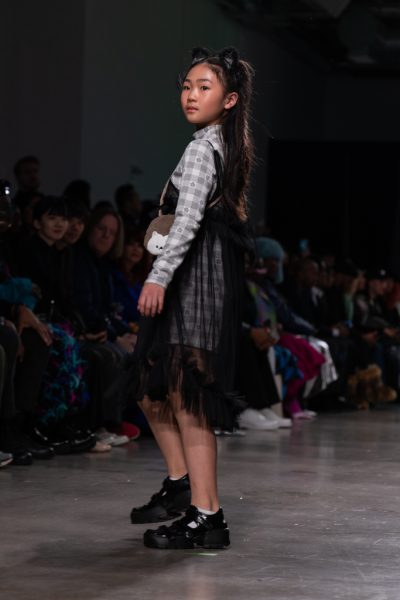
The Alex S. Yu show opened with dreamlike visuals on the screen at the front of the runway, perfectly setting up the tone of the clothing. Tulle, plaid and metallic fabrics stole the show, and elevated what would have otherwise been a casual sweater and skirt. The most repetitive silhouette was a sheer, colorful, tulle-pleated dress slipped over a long-sleeved top and pants. But the changing silhouettes and patterns kept every look fresh and alive.
An attendee of the show, Liya Zulu, said she loved the wearability of Yu’s designs. “The second collection was actually really pretty, I enjoyed it. It’s more my style as well — I love layering dresses,” Zulu said.
One model in both shows, Aluel Lual, explained that even though Longshi’s designs allowed her to wear something she would never otherwise get to, she felt more connected to Yu’s designs.
“It brought out the playful part of my personality that I connected to. I would say that that is especially my favorite because it was just so fun and light and airy,” Lual said.
While Alex S. Yu is vastly different from Longshi, the designers had one thing in common: both shows featured child models, although not for the same reasons. Instead symbolizing a greater message, Alex S. Yu used child models to show off the versatility of his clothes, as they could truly be worn by all ages. When the designs are so wearable but still joyful and delicate, there can be a clear focus on the craftsmanship of the garments, which was well done for every item in Alex S. Yu’s collection.
———————————
SHOW II
By Dharma Niles, Deputy News Editor
———————————
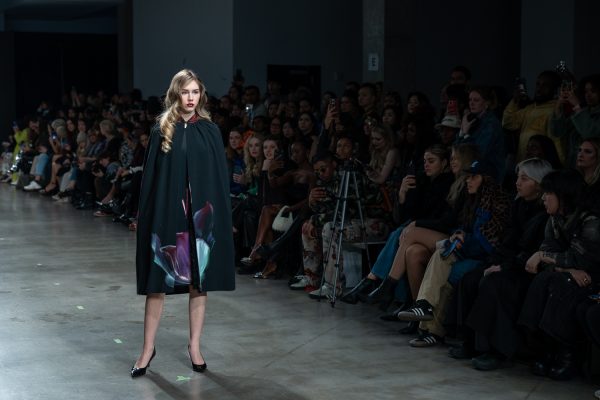
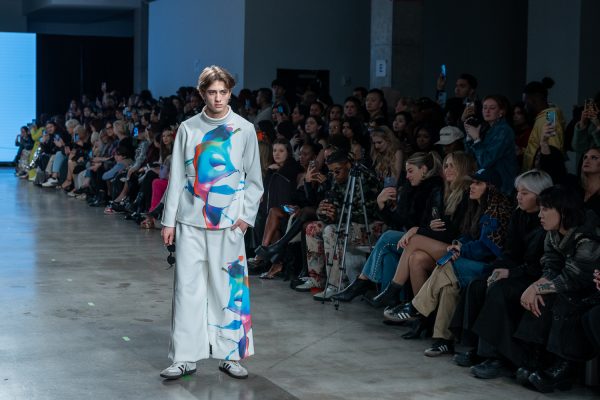
Naoko Tosa’s “Sounds of Ikebana” opened the show with a modernized take on traditional Japanese clothing, integrating technology and design in both fashion and fine arts. Tosa crafted a clean picture with vibrant waves that popped off the otherwise solid-colored sets.
The first look offered a futuristic rendition to a more casual, streetwear look. A set of slightly baggy white pants and an equally oversized mock neck was decorated with splashes of bright blues, oranges and pinks, which formed an asymmetrical triangle. The design mirrored a pattern of Ikebana, a traditional component in Japanese design.
The sequential sets offered similar patterns, each forming a dynamic flow when paired with the silhouette of more traditional, shapeless robes. Gold and red patterns adorned smooth, black fabric, creating a series of distinct contemporary looks that honored cultural elements. Tosa highlighted the lack of gender in her designs, and models spanned a vast age range reflecting the simplicity of the tailoring and styles.
Tosa’s work blended technology and art by using sound vibrations and a high-speed camera to capture patterns of Ikebana. She sought to contrast but acknowledge a series of natural devastations, noting the earthquakes and fires that recently struck Japan.
“Art, as you know, is living energy,” Tosa said. “That’s why this theme is happiness.”

The eccentricity of Yu Qian’s “Yilliaq” collection was apparent when the first model walked down the runway wearing a blue striped bodysuit that covered their face, draped in sheer black boxes with arm-like shapes sticking out and decorated with fabric sewn to resemble a balloon animal. Qian’s designs, each treated as a separate object, are influenced by mental health and disability-related topics.
The collection maintained its anomalous composition, each piece tied together by a peculiar shape and vibrant colors. The designs were often ornamented with shapes that elicited a distant sense of nostalgia, such as simple flower-like patterns and stuffed animals that vaguely resemble balloon animals. An electronic background track contributed to the collection’s novelty and provided a futuristic undertone.
Each model wore a different shape; geometry and color blended in culmination of a series of abstractly embellished designs. One model walked in a bright red dress, with white, arm-like extensions attached at various locations throughout the garment, in a notable crowd favorite look. Another wore a box embellished with graphic, colorful flowers — the size of the design warranting additional guidance as the model exited the stage.
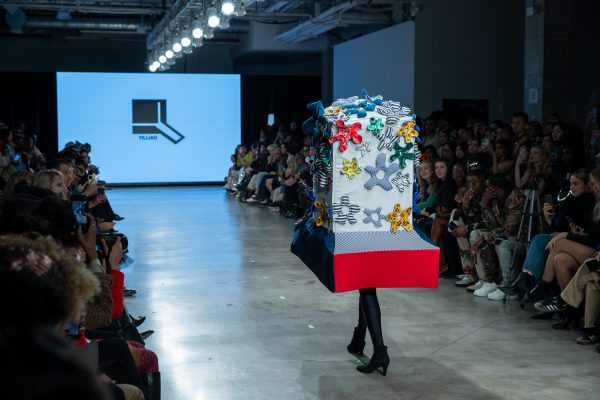
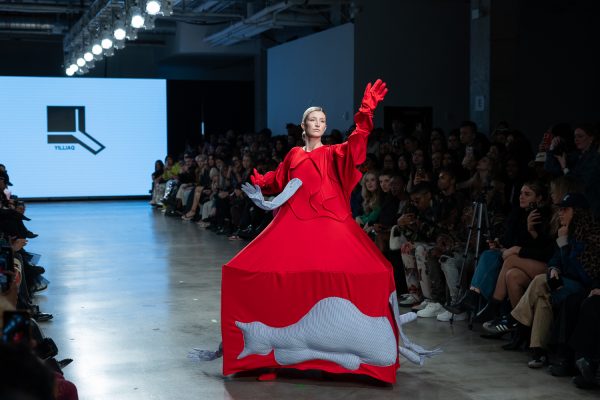
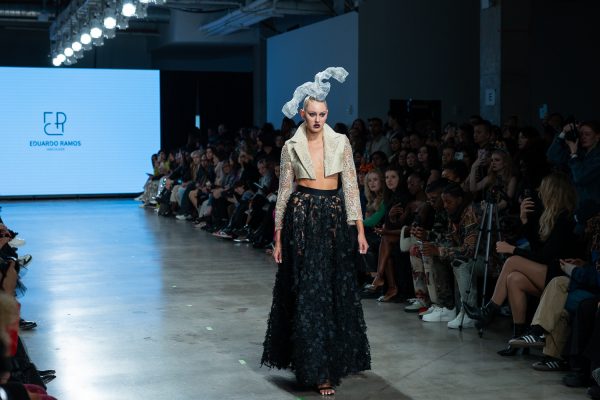
Stark contrasts between black and white represented a transition from life to death in Eduardo Ramos’ sleek collection. The eerie ensemble predominantly maintained a black-and-white color scheme with florals scattered throughout, an ode to the orchids Ramos associates with his childhood.
“It’s about the transition; we’re just alive for a brief period of time, and then we die,” Ramos told WSN. “I love death — but not in the sense of the creepy way, more about, ‘We’re all going to die, so make the best out of every day. Go after what you love.’’
The first model walked against a canvas-like white background, to an almost haunting, modernized orchestral track. The look experimented with textures, comprising a boxy, cropped white blazer with floral-patterned sleeves and a long skirt with black flowers overlapping mesh.
Almost every model was notably crowned with an oversized, white mesh headpiece against their otherwise uniform slicked-back buns. The headpieces took varying shapes, resembling horn-like features that added a mystic feeling to the collection. This concept was similar to Ramos’ work at last season’s London Fashion Week.
Ramos’ collection varied in silhouette and style, but maintained consistency with a black-and- white color palette and hard lines. The sharp tailoring, seen in boxy cuts in his designs, have previously been used to evoke a sense of empowerment and strength in Ramos’ collection.
The sharp designs were contrasted by lighter, floral designs adorning pieces throughout the collection, an ode to Ramos’ childhood and the collection’s overall theme.
“Growing up, my mom would have flowers, and it’s something that really reminds me of her,” Ramos said. “This is all about my childhood again; it’s about that journey.”
Each model’s outline paid homage to Ramos’ previous work with a structured silhouette that accentuated the waist. The tailoring of each piece was constructed with empowerment and strength in mind, especially within the fashion industry.
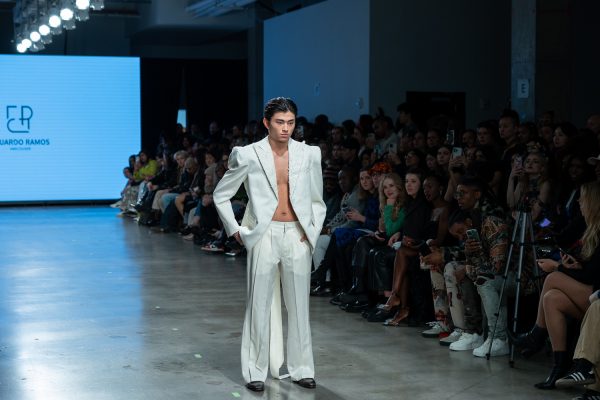
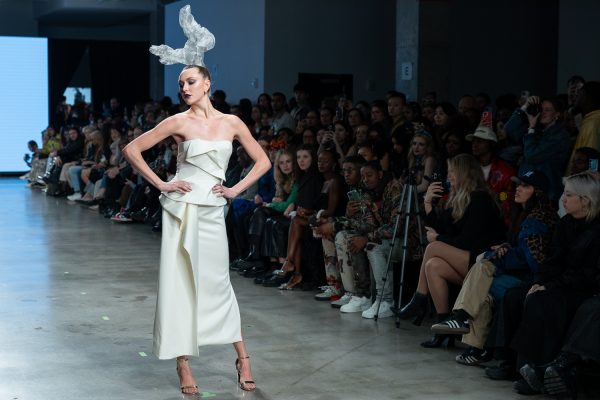
Contact Emily Genova and Dharma Niles at [email protected].




